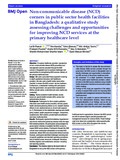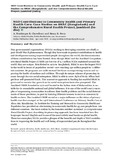| dc.contributor.author | Rawal, Lal B | |
| dc.contributor.author | Kanda, Kie | |
| dc.contributor.author | Biswas, Tuhin | |
| dc.contributor.author | Tanim, Md. Imtiaz | |
| dc.contributor.author | Poudel, Prakash | |
| dc.contributor.author | Renzaho, Andre M N | |
| dc.contributor.author | Abdullah, Abu S | |
| dc.contributor.author | Shariful Islam, Sheikh Mohammed | |
| dc.contributor.author | Ahmed, Syed Masud | |
| dc.date.accessioned | 2022-04-05T05:05:15Z | |
| dc.date.available | 2022-04-05T05:05:15Z | |
| dc.date.copyright | 2019 | |
| dc.date.issued | 2019-10-07 | |
| dc.identifier.citation | Rawal, L. B., Kanda, K., Biswas, T., Tanim, M. I., Poudel, P., Renzaho, A., Abdullah, A. S., Shariful Islam, S. M., & Ahmed, S. M. (2019). Non-communicable disease (NCD) corners in public sector health facilities in Bangladesh: a qualitative study assessing challenges and opportunities for improving NCD services at the primary healthcare level. BMJ open, 9(10), e029562. https://doi.org/10.1136/bmjopen-2019-029562 | en_US |
| dc.identifier.uri | http://hdl.handle.net/10361/16519 | |
| dc.description | This article was published in The BMJ Open [ © Author(s) (or their employer(s)) 2019. Re-use permitted under CC BY-NC. No commercial re-use. See rights and permissions. Published by BMJ.] and the definite version is available at: http://dx.doi.org/10.1136/bmjopen-2019-029562. The Journal's website is at: https://bmjopen.bmj.com/content/9/10/e029562 | en_US |
| dc.description.abstract | Objective To explore healthcare providers’ perspective
on non-communicable disease (NCD) prevention and
management services provided through the NCD
corners in Bangladesh and to examine challenges and
opportunities for strengthening NCD services delivery at
the primary healthcare level.
Design We used a grounded theory approach involving
in-depth qualitative interviews with healthcare
providers. We also used a health facility observation
checklist to assess the NCD corners’ service readiness.
Furthermore, a stakeholder meeting with participants
from the government, non-government organisations
(NGOs), private sector, universities and news media was
conducted.
Setting Twelve subdistrict health facilities, locally
known as upazila health complex (UHC), across four
administrative divisions.
Participants Participants for the in-depth qualitative
interviews were health service providers, namely upazila
health and family planning officers (n=4), resident medical
officers (n=6), medical doctors (n=4) and civil surgeons
(n=1). Participants for the stakeholder meeting were health
policy makers, health programme managers, researchers,
academicians, NGO workers, private health practitioners
and news media reporters.
Results Participants reported that diabetes, hypertension
and chronic obstructive pulmonary disease were the major
NCD-related problems. All participants acknowledged the
governments’ initiative to establish the NCD corners to
support NCD service delivery. Participants thought the NCD
corners have contributed substantially to increase NCD
awareness, deliver NCD care and provide referral services.
However, participants identified challenges including lack
of specific guidelines and standard operating procedures;
lack of trained human resources; inadequate laboratory
facilities, logistics and medications; and poor recording
and reporting systems.
Conclusion The initiative taken by the Government of
Bangladesh to set up the NCD corners at the primary
healthcare level is appreciative. However, the NCD corners
are still at nascent stage to provide prevention and
management services for common NCDs. These findings
need to be taken into consideration while expanding the
NCD corners in other UHCs throughout the country | en_US |
| dc.language.iso | en_US | en_US |
| dc.publisher | BMJ Journals | en_US |
| dc.relation.uri | https://bmjopen.bmj.com/content/9/10/e029562 | |
| dc.subject | Health policy | en_US |
| dc.subject | Health services administration & management | en_US |
| dc.subject | Non-communicable disease | en_US |
| dc.subject | Organisation of health services | en_US |
| dc.subject | Public health | en_US |
| dc.subject | Service delivery | en_US |
| dc.title | Non-communicable disease (NCD) corners in public sector health facilities in Bangladesh: A qualitative study assessing challenges and opportunities for improving NCD services at the primary healthcare level | en_US |
| dc.type | Journal Article | en_US |
| dc.description.version | Published | |
| dc.contributor.department | Brac James P. Grant School of Public Health | |
| dc.identifier.doi | http://dx.doi.org/10.1136/bmjopen-2019-029562 | |
| dc.relation.journal | BMJ Open | |




